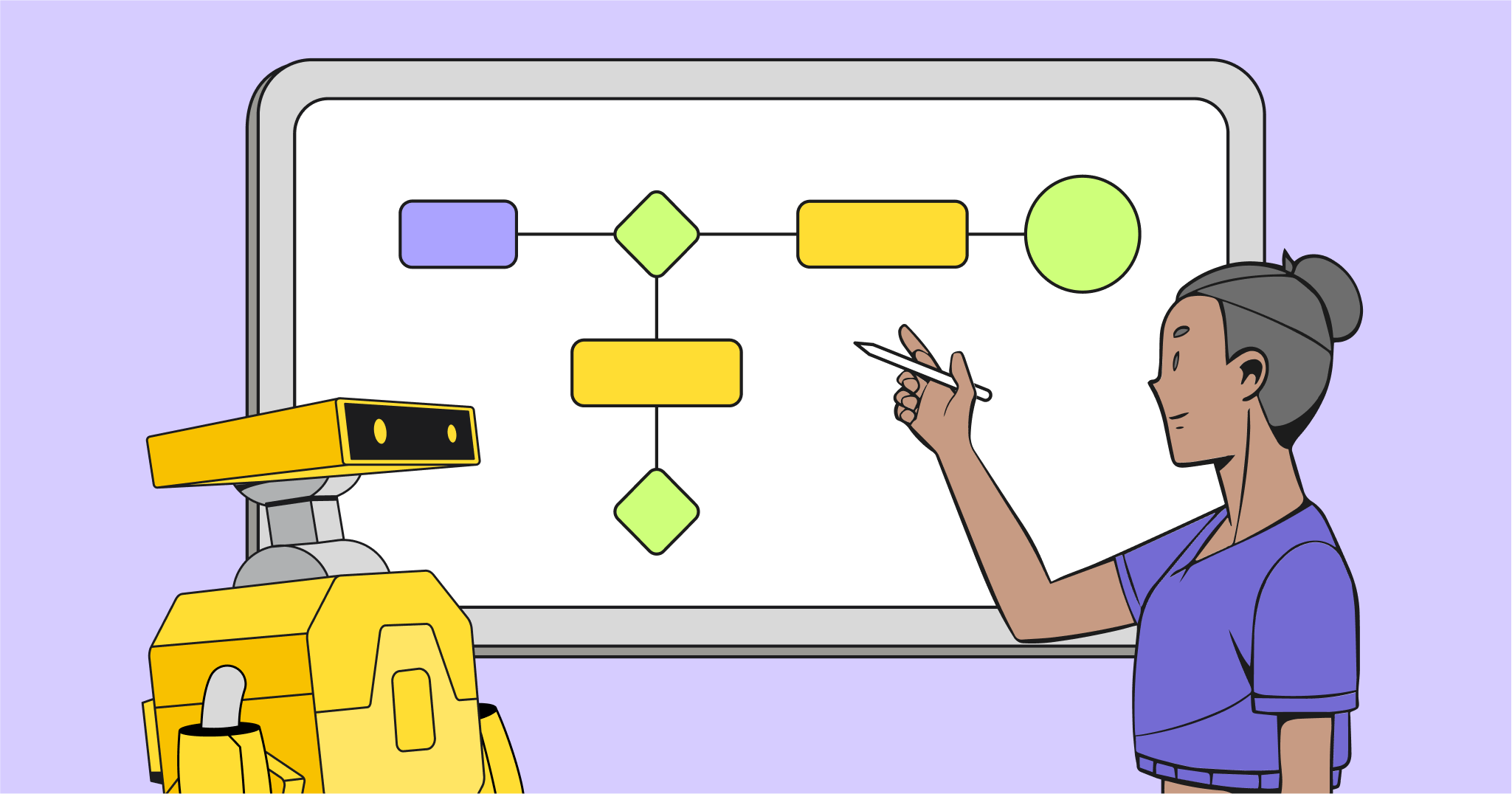Asking good questions is one of the hardest skills to master. Anyone who’s ever given an interview participated in a panel or webinar, or even gone on a date knows that an uninspired question can really kill the conversation.
When it comes to brainstorming, good questions are everything. We’ve all been in brainstorming sessions that started out fine but quickly lost steam, or that never took off at all. By mastering the art of asking questions, you give yourself and your teammates more opportunities for great brainstorms. But how do you actually do it?
Brainstorming is a creative technique for tackling complex problems by generating spontaneous ideas to find a solution. An essential part of kicking off a project, brainstorming works best with groups rather than individuals.
This team activity, when done well, allows teams to think more freely and explore a wide variety of ideas and perspectives. Solutions are often reached more effectively this way than by a single person, or a team using obvious or conventional tactics.
This article will empower you to ask great brainstorming questions. The most productive questions are open-ended, short, and simple. Shifting from descriptive, easy questions (What’s working? What’s not?) to more complex, speculative ones (Why or why not? What if?) tends to produce better breakthroughs. We’ll walk you through five different types of questions, examples of each, and tools that can help you build questions of your own.
Why are brainstorming questions so important?
Brainstorming sessions are designed to be open-ended and spontaneous. So, shouldn’t our questions be the same? Why should we put any thought into them beforehand? To understand why we should care about questions, let’s dig into the psychology behind brainstorming.
In our day-to-day lives, we constantly monitor what we say because we fear judgment. At work, we double-check our emails multiple times before sending them. We hold back during meetings because we don’t want to look dumb. This is understandable. People are hired, fired, and promoted based on whether they make intelligent decisions.
But brainstorming disrupts the flow of everyday life. If you’re doing it right, a brainstorm introduces vulnerability. Speakers feel free to throw out ideas without fear of judgment—and listeners do not judge.
Creating that kind of environment is not easy! It’s a fundamental disruption of our thinking and behavior. To promote ideation, we have to start our brainstorms with questions that immediately help everyone feel safe to share their thoughts and feelings. Every question that follows must continually reinforce this environment. If a question is too open-ended, closed-off, or just inappropriate for a particular meeting, participants will shut down.
In short, asking good questions is a high-stakes game. Luckily, we’re here to help.
1. Observational Questions
Observational questions can be answered by your senses: anything that can be seen, heard, touched, or felt. These types of questions are useful for kicking off a brainstorm. They invite participants to set the stage for the discussion, taking stock of what they’ve experienced.
For example, try starting your brainstorm with an open-ended observational question like:
- What do you notice about the product we’re looking at?
- When you open up this web page, what jumps out at you?
- What are we trying to achieve in this meeting?
- What concrete steps should we take to move forward?
Many brainstorms stall when the participants feel like they’re being led in a specific direction, and they become self-conscious about giving the “right” answer. By asking an open-ended observational question, you can help eliminate that fear. Instead, your teammates are simply commenting on whatever they happen to notice.
Observational questions work well in a variety of settings. The entire group can share observations, people can pair up, or people can jot down their ideas. It might help for people to sketch out their observations before sharing them with the wider group. Experiment to see what works best—this can be part of the fun!
2. Introspective Questions
As the name suggests, introspective questions encourage participants to think deeply by looking inward. Rather than focusing on visual processing, participants focus on emotional or cognitive processing.
Instead of asking participants what they notice about a web page, you might ask:
- How easy or difficult is it to interact with this web page?
- Is there an element of this web page that surprises you?
- Does anything about this page remind you of other websites you’ve visited?
- Do you have any questions about the page?
- How do you feel about this project?
- What about this project excites you (or not)?
Introspective questions are powerful tools because they can inspire your teammates to dig into their emotions and experiences. It’s best to use them in the middle of a session, after participants are already warmed up, to keep the flow of conversation strong. But be careful—because introspective questions require such deep thought, they can easily exhaust your teammates. Use them with care to create meaningful and actionable conversations.
Since introspective questions can have personal or emotional undertones, it can help to encourage people to write down their responses or share them in small groups. That gives everyone ample opportunity to share honest answers in a way that makes them feel comfortable. Allow your teammates time to reflect before coming together to share with the broader group.
3. Retrospective Questions
Retrospective questions ask participants to look backward, allowing their teammates to share the significance or implications of the topic at hand. Retrospective questions are important for encouraging everyone to think about what they learned from the session. They’re a fun and efficient way to start translating ideas into action.
You might ask:
- What have you learned?
- What would you like to learn more about?
- What should we do differently next time?
- What additional information should we gather before we start this project?
- What categories can we sort these ideas into?
Though some facilitators might be tempted to ask retrospective questions at the beginning of the brainstorm, they are better suited to the end. Retrospective questions allow you to wrap up the conversation by distilling your thoughts and ideas into learning and next steps. If you ask these questions at the beginning of the brainstorm, it doesn’t leave room for the conversation to develop. But by using them to conclude, you can better set the stage for further discussions.
Become an online brainstorming master
4. Lateral Thinking Questions
When thinking or talking about a problem, we can easily fall into predictable patterns. It makes sense: as humans, we’re hardwired for patterns. We follow the same daily routines, communicate in predictable ways, and think in familiar terms. But in brainstorming, you want to cast off the familiar and predictable—which is easier said than done!
Lateral thinking questions help you do just that. These questions are designed to throw a wrench into your brainstorm. They’re surprising, sometimes even jarring. The point is to encourage participants to think about the problem or topic in a new way.
Possible questions include:
Don’t be afraid to get creative with these questions. It’s a brainstorm, so you’re here to be vulnerable and take chances.
- What if we scrapped this approach and tried something else?
- What would happen if we didn’t do this project at all?
- How can we think about this problem from someone else’s perspective?
- If we had infinite resources, what would this look like?
5. Actionable Questions
As the brainstorm winds down, your teammates will want to find out what they can do with the information they’ve gathered. Sometimes, it can be challenging to see how brainstorms—which tend to be chaotic, messy, and frenetic—can actually turn into a project or process. That’s where actionable questions come in.
Some actionable questions include:
- What should we start, stop, or continue doing? Be specific.
- Who is taking the first step?
- Which of these action items should we tackle first?
These five types of questions should give you a good foundation to start building great brainstorming sessions. Try them out in your next meetings!
When you start to ask these questions, make sure you’re ready to end the meeting since actionable questions tend to signify that you’re wrapping up. Use actionable questions to double-check that everyone is on the same page before moving forward.






